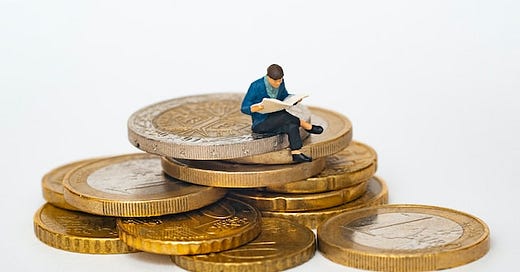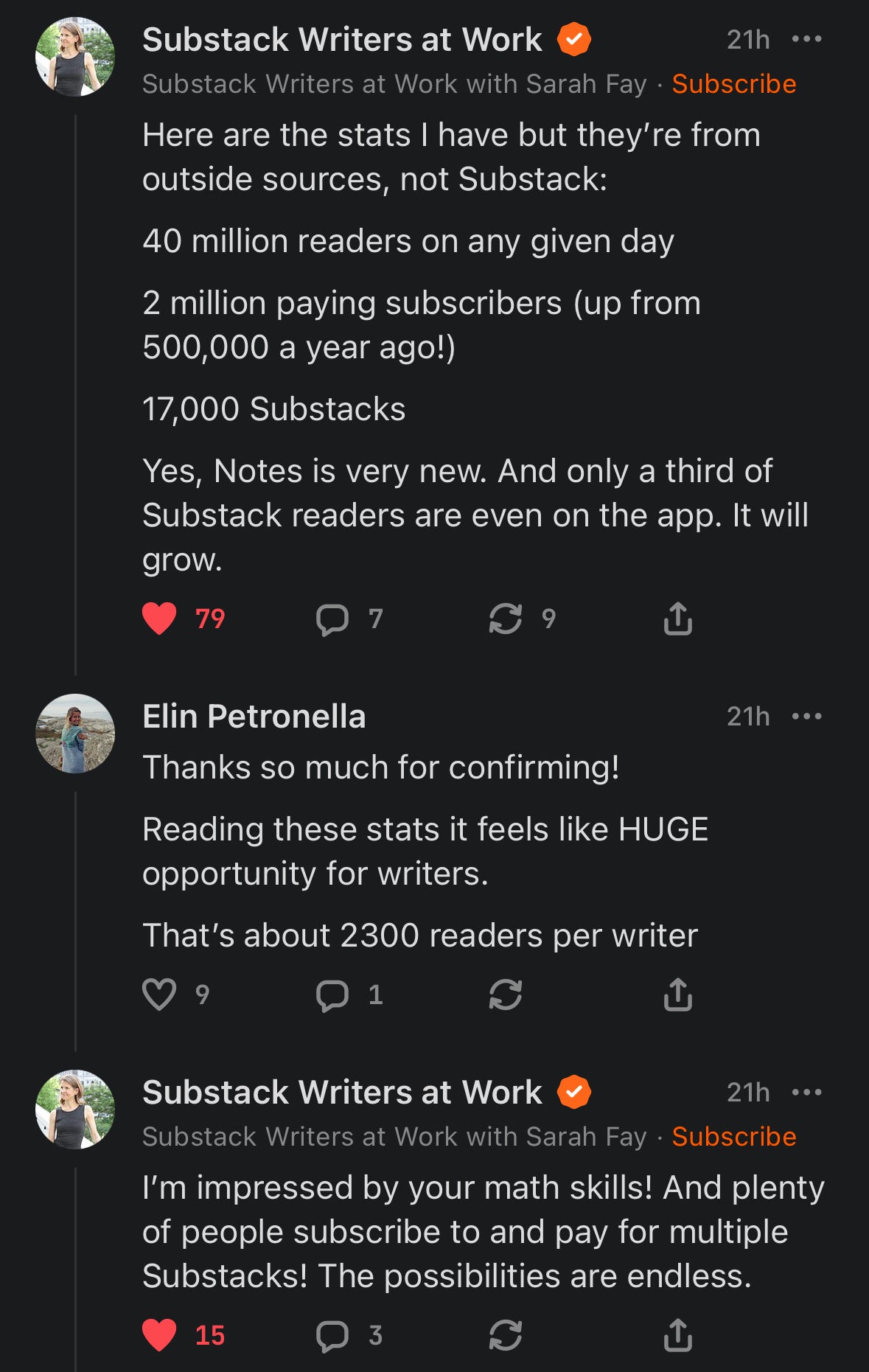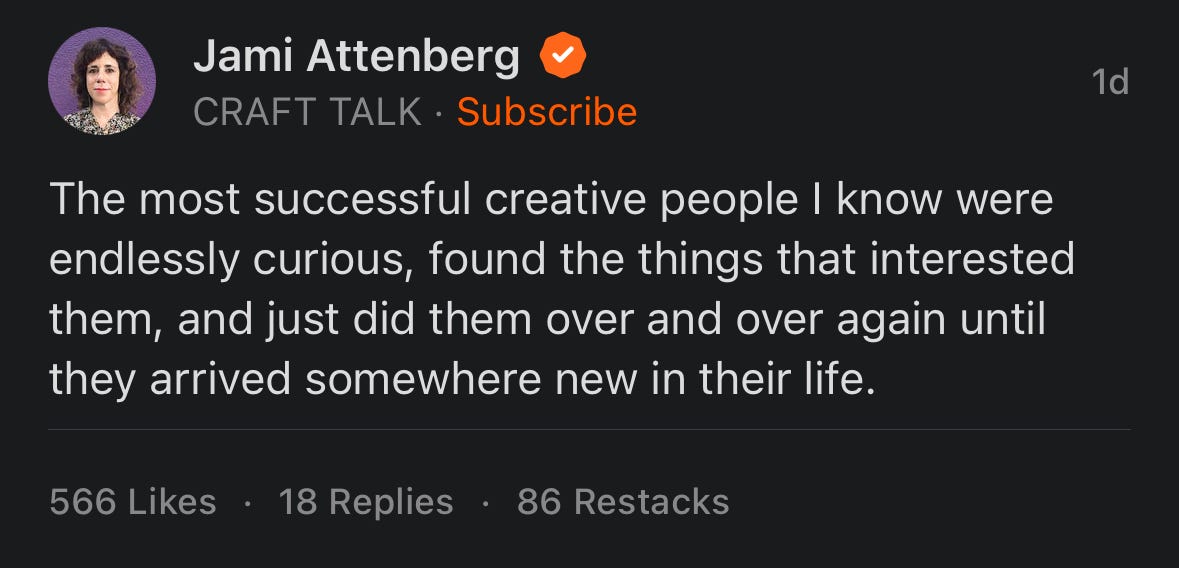When to go paid on Substack?
An honest reflection on my Unorthodox approach to Substack as a business
Heads up: this essay is too long to fit into an email. To read the full story click “view entire message” or head to the article directly on Substack here.
Let’s talk about the elephant in every artist room: Money.
On Substack that generally means: When to turn on the paid option and what is the motivation for doing so?
We can probably all conclude that the main reason is fair compensation for the time and effort we invest to write.
Fair enough.
But it doesn’t answer the question of when. Does it automatically mean that one should turn on the paid option right away?
Not necessarily, if you ask me (though I’m not the expert here, so for all it’s worth: Don’t take my advice.)
Disclaimer: This article is based on personal reflections and my own experience of having grown and run an online art business for the past 7 years (including an audience of about 500k across mainstream social media).
This article is not intended as recommended advice. I’m simply in no position to give it. Rather, I aim to play with the idea that perhaps there are multiple possibilities for how to do “this thing” called Substack.
Perhaps, if we start to ask more questions, we’ll be able to get a deeper and clearer understanding for what is aligned with our own intention and work, disregarding what the majority seems to do.
When I joined
a few weeks ago I had a very clear plan for what I wanted to do:Grow my list in-house* to a minimum of 1000 dedicated readers and then turn on the paid option with a big celebration launch.
Based on the average statistics that 5-10% convert into paid readers, it would hopefully make me a
bestseller within a few days from launch (you need 100 paid members for that right?).Ones I built the momentum and social proof of being a Substack bestseller, I’d be able to enjoy a more steady growth going forward despite a paywall on selected (probably most) articles/essays.
On what do I base this assumption?
Thanks to writers who share their Substack growth graphs, I quickly noticed a pattern; The exponential growth curve tends to drastically take off at around the 1000 subscriber-mark (for “in-house” lists especially). Is this by accident or by algorithmic design? How can I best leverage my own chances?
From a reader/consumer perspective it feels “easier” to restack and share free essays compared to paid ones. Hence, as long as you’re in the growth-phase, it would make sense to keep articles free as much as possible.
So why not turn on the paid option but leave posts free for all? Because I’d lose the momentum of a big first launch to kick things off.
I noticed a stark difference from a “social proof” perspective when I received the blue tick mark on Instagram five years ago. Couple the blue tick with almost 200k followers and the decision for someone to subscribe is much quicker (this is mass psychology where the evident proof that others enjoy a certain artist/writer tells our subconscious that there’s a greater chance we’ll enjoy it too. The market has already “approved” the artist to some extent.)
Translated to Substack, I noticed on my own subconscious behaviour (as much as I’m embarrassed to admit it) that I generally read a couple more essays before making a decision to subscribe to a non-bestseller compared to a bestseller.
What a utopia if this wasn’t the case.
Simultaneously, with the experience of having a huge audience, I know how much sweat and tears that goes into it. As such, I don’t think the bestseller badge is an unfair advantage, but rather a well-deserved trophy of achievement and good work. You’ve earned the badge and it should be respected as such WITHOUT unjustified jealousy from other aspiring writers.
*When I refer to “in-house”, I mean to grow my list almost exclusively within the Substack network. I have not imported any email list, nor marketed through external channels. As of writing this, I’ve merely made a small announcement to my previous list about this new creative project through which a little over 50 people came along. The rest on the list are all from
.
I’m not so sure anymore.
I contemplate on whether my hesitation to follow my initial intent to wait to go paid comes from a place of FOMO vs. a justified change of mind in response to further observation of the platform atmosphere.
I’ve hardly stumbled upon anyone who doesn’t have a paid option regardless of their subscriber count. How come?
From the outside it feels as though there are two opposing camps:
I’m a real artist and refuse to market or sell myself
I refuse to work for free
Personally, I consider myself to be part of the 2nd gang, and yet… I don’t have a paid option turned on.
Does this make me a fraud for not complying with the general advice of “turn it on to show your readers that you respect and value your own work” ?
It made me think of something my Congolese ex-boss screamed at me when I worked for an NGO in rural South Africa 9 years ago:
“Don’t finish in advance. You make everyone else look bad!”
For context; I had handed in a written assignment ahead of deadline.
Amazing, right? Clearly, not at all.
I remember being gobsmacked. Stunned. Confused. Surprised. Ashamed. Angry. All the feelings at ones.
It was the first time that I experienced increased productivity and individual achievement as something negative.
We were a team. And as such, we needed to set the bar at a comfortable level for everyone rather than to push each other to near collapse. (Hello the West, I’m looking at you).
I began to ask myself whether to remain unpaid made my other paid writer colleagues look bad?
That I’m perceived as some self-proclaimed hero to offer everything for free for the greater good of everyone (which I’m not btw.)
Would my stance for soulful growth and business feel hypocritical if I don’t display how I value my work through offering the paid option right away?
Is a “big-ass” launch suitable on this platform? What does it even mean to be suitable? Is it just a way to limit myself, or is it a question of mutual respect of other writers and readers?
It’s one thing to turn on the paid option, and another to *actually* get paid.
Just because you open shop doesn’t mean that customers will show up. You need to share about it: Tell your peeps or you’ll get bored at the cash-counter.
Naturally, the bigger contact list you’ve got before you open the doors, the more of a buzz you’ll create.
I’ve seen writers feel discouraged and disheartened for not having big conversions. But does the math add up yet? At what free subscriber count can you start to “slightly expect” to have upgrades in the first place?
Before we get too run down, let’s lift the spirit again with some encouraging statistics, fresh from
Currently there are about 2300 potential readers per writer of which an average of 117 paid/publication (that’s the same as everyone having the possibility to be bestsellers!).
How amazing is that for a stat?!
Ps. If we assume the average numbers above, 117 paid out of 2300 free shows a conversion rate of about 5%, which seems very realistically aligned with figures I’ve seen floating around elsewhere.
Let’s go back to why I consider to wait to go paid:
said something in a recent note that made me stop in my tracks. It clearly reflects my philosophy and reason for why I initially intended (and most likely still intend) to wait to go paid. She writes:“But how did I pick those books? At least 75% were referred to me by a friend OR I had some kind of connection with the author already. They were a celebrity that I followed or they are a writer whose other works I enjoyed and I decided to read more by them. When do I pre-order books? When I’m already connected in some way to the writer.“
I consider my Substack to still be in the newborn stage. I still need to get crawling before I can walk let alone run.
This means that I want to write more. I want to be read more. With each new reader I get a better understanding for what makes you resonate with me. And with each new post you’ll be able to get connected even deeper (to the point where you WANT to read more of my stuff).
just gave the most marvellous feedback in a recent conversation about the whole idea of “when to go paid”:“It’s one big mad experiment isn’t it… and that’s what I love about your posts. They are high quality and engaging but they don’t feel super planned out (not that planning is a bad thing at all, it’s just refreshing to see someone approach it so differently).”
As I read, it felt like a warm hug around my creative ego (thank you, Bella!). This is it. It’s exactly what my intention is. She gets it. It might mean that others gets it too…
I’m not good at planning. Frankly, I don’t want to.
I’m not good at scheduling. But I don’t want to do that either at this point.
My intention is to write from a place of curiosity and spontaneous reflection which I aim to articulate as clearly as possible. All while simultaneously tie it to lived experiences to bring as much value as possible (and hopefully contribute to stirred reflections in return).
You can imagine how my heart sang to the tune of this note by
. She doesn’t know me yet. But she already gets it.To write can change your life. To read even more so.
All it takes is one powerful idea that deeply touches you in a way that may change the whole trajectory of your destiny - Fascinating, right?!
When I reach that point of feeling comfortable in my ability to share and build that connection, then I’m ready to go paid.
And I’ll be ready to go ALL in without second guessing whether my reader gets value. Because I know, the right reader already does.
I’ve read many who share that to turn on paid makes them more invested in the project. They can’t bail out as soon as they’ve got a paid subscriber.
Valid point.
I honestly had to reflect on that a bit as I found myself surprised by my own indifference.
Personally, to go paid or not is not related to my drive or commitment. It’s the creative challenge of building something from scratch. To see if I’m able to “do it all over again”. That entices me.
Can I really make it? Or are my demons right, that I’m just an imposter like everyone’s devils wants them to believe?
What happens when I go paid?
said something brilliant in her post “Are we undervaluing and undercharging our work on Substack?”:“We give too much of ourselves away here if we’re not careful, because we worry we’re not giving enough “good value” or that it’s not “worth it.”
I’ve seen this happen across the spectrum. Not just from recent observations here on
but also on multiple other mainstream social media.We’re so engrained that more value means more stuff. As a consumer I don’t want more stuff. I want better stuff.
So, instead of overwhelming myself with everything I can potentially add to my offering the day I choose to go paid… I’ll be the one who opt for the writing and the ideas to be the end goal in and of itself.
If I wanted to do extensive workshops and time consuming events, I would’ve stayed on my own platform, the Charles and Elin Academy.
I’m on Substack because I chose to write as my medium. As a result, writing will be my product and the subsequent ideas and reflections the bonus services on top.
I don’t buy books with the expectation to access the author’s trainings and workshops for free too.
As
reflects in the aforementioned article, I would not be able to offer workshops for £35/year (which is the average yearly payment for the publications included in her platform survey). I would work myself to death and still not have enough to feed my children (I live in a high-tax country!)My unorthodox plan of when to go paid on Substack is this:
My gut tells me to build my readership first and to be very intentional about when and how I turn on the paid feature (which may very well put the majority behind a paywall).
But no stress. No urgency offer just yet. There’s still plenty of time to subscribe for free as I’m still just warming up.
And who knows, maybe it will change along the way? The only constant in life is that it always changes.
I’m aware that this post may have made more than two people cringe.
I know that some Substack experts recommend to turn on the paid sooner than later.
Other coaches like the lovely
says:“My answer to the question is nuanced and it depends who is asking and where their motivations are coming from. “
This is one of many reasons for why she has dedicated one of her publications
to be an educative space for all stackers.I know that it’s a risk to go against the stream - even more so to do it in public.
Thankfully I’m quite used to go against the stream, so I think I’ll be OK.
I’d also like to thank everyone who engaged and shared your experience on the note I made yesterday to test the idea (I intentionally threw some spaghetti on the wall to see what sticks as
wrote recently).You’re golden:
For the curious, below is that Spaghetti note, where you can go in to read all the excellent responses:
If you loved this article, you may also enjoy some of my recent essays (ps. don’t forget to leave your comment first!):
Thanks for being here! I appreciate you.
Elin, x
Ps. Don’t miss to subscribe if you haven’t already. This will be a fun ride!








The ever agonizing debate we have with ourselves and others in regards to money. It never it ends, does it? I'm sure there will be people wondering when the best time is long after we are all gone.
Love reading your process and the thought provoking reflections it brings up. I made the decision that my writing and essays will always be free but that I offer extra bits like audio voice notes and practices and deepening experiences behind the paywall, and a discount to my other offerings for those that pay to subscribe. This feels good right now but it’s still early days and I’m experimenting. I think it will be an ever evolving process... but I too loved Laura’s piece this week. Thank you for sharing xx